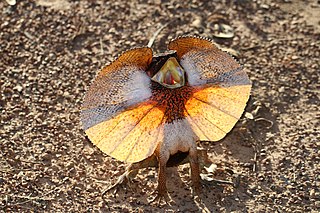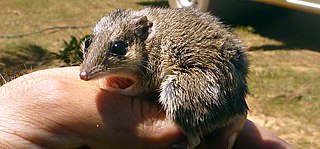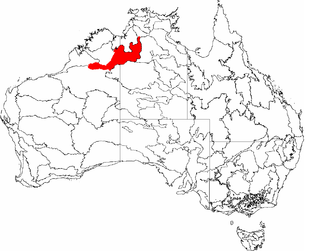
Sorghum is a genus of about 25 species of flowering plants in the grass family (Poaceae). Some of these species are grown as cereals for human consumption and some in pastures for animals. One species is grown for grain, while many others are used as fodder plants, either cultivated in warm climates worldwide or naturalized in pasture lands.

Kakadu National Park is a protected area in the Northern Territory of Australia, 171 km (106 mi) southeast of Darwin. It is a World Heritage Site. Kakadu is also gazetted as a locality, covering the same area as the national park, with 313 people recorded living there in the 2016 Australian census.

Tropical and subtropical moist broadleaf forests (TSMF), also known as tropical moist forest, is a subtropical and tropical forest habitat type defined by the World Wide Fund for Nature.

The long-tailed planigale, also known as Ingram's planigale or the northern planigale, is the smallest of all marsupials, and one of the smallest of all mammals. It is rarely seen but is a quite common inhabitant of the blacksoil plains, clay-soiled woodlands, and seasonally flooded grasslands of Australia's Top End.

The frilled lizard, also known as the frill-necked lizard or frilled dragon, is a species of lizard in the family Agamidae. It is native to northern Australia and southern New Guinea. This species is the only member of the genus Chlamydosaurus. Its common names come from the large frill around its neck, which usually stays folded against the lizard's body. It reaches 90 cm (35 in) from head to tail and can weigh 600 g (1.3 lb). Males are larger and more robust than females.

Southwest Australia is a biogeographic region in Western Australia. It includes the Mediterranean-climate area of southwestern Australia, which is home to a diverse and distinctive flora and fauna.

Central Australia, also sometimes referred to as the Red Centre, is an inexactly defined region associated with the geographic centre of Australia. In its narrowest sense it describes a region that is limited to the town of Alice Springs and its immediate surrounds including the MacDonnell Ranges. In its broadest use it can include almost any region in inland Australia that has remained relatively undeveloped, and in this sense is synonymous with the term Outback. Centralia is another term associated with the area, most commonly used by locals.

The unofficial geographic term Northern Australia includes those parts of Queensland and Western Australia north of latitude 26° and all of the Northern Territory. Those local government areas of Western Australia and Queensland that lie partially in the north are included.

The Tanami Desert is a desert in northern Australia, situated in the Northern Territory and Western Australia.

Hadrurus arizonensis, the giant desert hairy scorpion, giant hairy scorpion, or Arizona Desert hairy scorpion is a large scorpion found in North America.

The NAB League Boys is an under-19 Australian rules football representative competition held in Australia. It is based on geographic regions throughout country Victoria and metropolitan Melbourne with each team representing twelve Victorian regions, while a thirteenth team from Tasmania was reintroduced in 2019. The competition is sponsored by National Australia Bank (NAB), having previously been sponsored by the Transport Accident Commission (TAC) since its inception.

The Carpentarian dunnart also known as Butler's dunnart is a marsupial with a puffy brown or mouse grey colour above and the underside of white, similar to its close relative the Kakadu dunnart. Head to anus length is 75-88mm with a tail of 72-90mm long for a total length of 147-178mm. Weight varies from 10-20g depending on a variety of factors including sex, food abundance, habitat etc.

The rainbow pitta is a small passerine bird in the pitta family, Pittidae, endemic to northern Australia, most closely related to the superb pitta of Manus Island. It has a velvet black head with chestnut stripes above the eyes, olive green upper parts, black underparts, a bright red belly and an olive green tail. An Australian endemic, it lives in the monsoon forests and in some drier eucalypt forests.

The star finch is a seed-eating bird species found in northern Australia. It has a distinctive red face and bill, and broad white spots down its flanks. One of its three subspecies may be extinct.

The Ord Victoria Plain, an interim Australian bioregion, is located in the Northern Territory and Western Australia, comprising 12,540,703 hectares.
The Arnhem Land rock rat also known as the Arnhem rock-rat and by the Indigenous Australian name of kodjperr is a species of rodent in the family Muridae. It is found only in the Top End Region of the Northern Territory in Australia.
The Carpentarian rock rat is a species of rodent in the family Muridae. It is found only in Australia.

Mertens' water monitor, also called commonly Mertens's water monitor, and often misspelled Mertin's water monitor, is a species of lizard in the family Varanidae. The species is endemic to northern Australia, and is a wide-ranging, actively foraging, opportunistic predator of aquatic and riparian habitats. It is named after German herpetologist Robert Mertens.

Drosera paradoxa is a carnivorous plant in the genus Drosera and is endemic to the Northern Territory and Western Australia. It is a perennial herb with a woody stem that can grow as tall as 30 cm (12 in). The leaves on the single terminal rosette are erect or horizontal and held at the end of linear petioles, which are typically 20–35 mm long at flowering time. The carnivorous leaves are sub-orbicular and small at 2.5–3 mm wide and 2–3 mm long. Inflorescences are 20–40 cm (8–16 in) long with pink or white flowers being produced on 50- to 70-flowered crowded racemes from July to September during the dry season.

Seasonal tropical forest, also known as moist deciduous, semi-evergreen seasonal, tropical mixed or monsoon forests, typically contain a range of tree species: only some of which drop some or all of their leaves during the dry season. This tropical forest is classified under the Walter system as (i) tropical climate with high overall rainfall and (ii) having a very distinct wet season with dry season. These forests represent a range of habitats influenced by monsoon (Am) or tropical wet savannah (Aw) climates. Drier forests in the Aw climate zone are typically deciduous and placed in the Tropical dry forest biome: with further transitional zones (ecotones) of savannah woodland then tropical and subtropical grasslands, savannas, and shrublands.

















